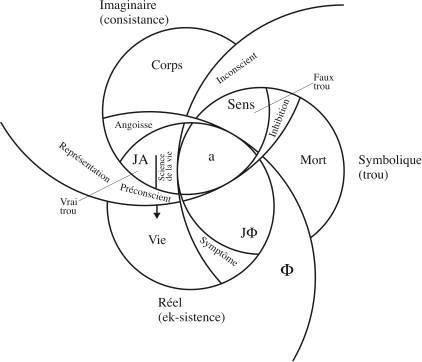According to Jacques Lacan, sexuation, as distinct from biological sexuality, designates the way in which the subject is inscribed in the difference between the sexes, specifically in terms of the unconscious and castration […] Lacan’s choice of the term ‘sexuation’, and not sexuality, indicates that being recognized as a man or woman is a matter of the signifier.”
https://nosubject.com/Formulas_of_Sexuation
According to Lacan’s graph of sexuation – it is Woman who can achieve this ‘Other Jouissance’, but not always. And importantly, the position of Woman exists not as some biological trait, but in language. Woman belongs to the realm of the signifier.
In A Thousand Plateaus (1980), Deleuze and Guattari constantly emphasize the necessity of passing through the stage of “becoming-woman”[…]This claim cannot be understood outside Lacan’s account of sexuation in Seminar 20: Encore (1972). There it will be noted that the masculine side of the graph of sexuation is a highly formalized version of the Oedipus, in addition to being the side that aims at totalization and identity in the social field. The feminine side of the graph of sexuation, by contrast, is premised on the logic of the “not-all” and the absence of anything like totality. Where the masculine side is the logic of the transcendent, the feminine side is the side of the immanent.”
https://larvalsubjects.wordpress.com/2008/12/04/deleuze-and-guattari-avec-lacan
The feminine side of the graph, the logic of the non-all which can grasp the Other Jouissance (JA) is also the position of the Psychotic. Perhaps here already we can see the smooth transition from Lacanian Psychoanalysis into Guattarian Schizoanalysis.
In psychosis, jouissance is reintroduced in the place of the Other. The jouissance involved here is called jouissance of the Other, because jouissance is sacrificed to the Other, often in the most mutilating ways, like cutting off a piece of the body as an offering to what is believed to be the command of the Other to be completed.
[…]
The practice of psychoanalysis with the psychotic differs from that of the neurotic. Given that the psychotic is in the position of the object of the Other’s jouissance, where the uncontrolled action of the death drive lies, what is aimed at is the modification of this position in regard to the jouissance in the structure […] Psychoanalysis attempts to modify the effect of the Other’s jouissance in the body, according to the shift of the subject in the structure. The psychotic does not escape the structure, but there can be a modification of unlimited, deadly jouissance.”
https://nosubject.com/Jouissance
Woman is pas toute [not-all]”
[…]
il n’y a pas La femme [there is no such thing as Woman]”
[…]
Il n’y a pas de rapport sexuel [there is no sexual relation]”
Lacan, Seminar XX, Encore.
–
Or, as Žižek says in The Pervert’s Guide to Cinema during the scenes of analysis of Alfred Hitchcock’s Vertigo:
To see what is lacking in reality [objet petit a] to see it as that, there you see subjectivity. To confront subjectivity means to confront femininity. Woman is the subject. Masculinity is a fake. Masculinity is an escape from the most radical, nightmarish dimension of subjectivity.”
This is why Anti-Œdipus is so special to me.
